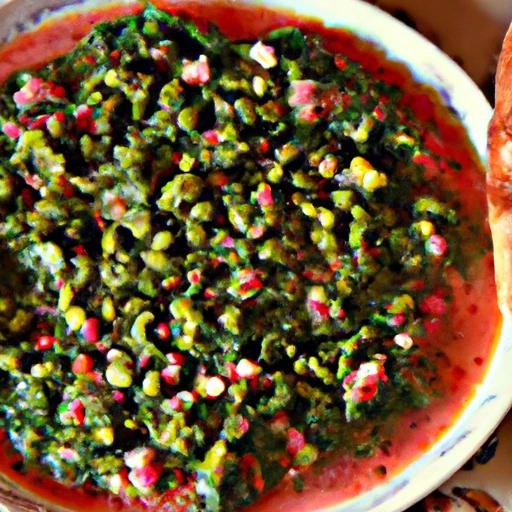Yemeni Helbeh
Yemeni Helbeh Recipe - Vegetarian Dish with Fenugreek Seeds and Zhug
Introduction

Yemeni Helbeh is a spicy and flavorful condiment made with fenugreek seeds, zhug, lemon juice, and tomato. It is a popular dish in Yemen and is often served with bread or as a side dish with a meal.
History
Helbeh has been a staple in Yemeni cuisine for centuries. It is believed to have originated in Yemen and has since spread to other Middle Eastern countries. The combination of fenugreek seeds, zhug, lemon juice, and tomato creates a unique and delicious flavor that is loved by many.
Ingredients
- 2 tbsp of fenugreek seeds
- 0.25 cup of zhug
- 0.5 small lemon, juice of
- 1 tomato
How to prepare
- Soak the fenugreek seeds in water for several hours or overnight.
- Drain any excess liquid, leaving a moist paste.
- Gradually add up to 0.5 cup of water to the paste using a wooden spoon.
- Mix in the zhug, lemon juice, and tomato.
- Adjust the seasonings according to taste. It should be very spicy.
- This can be enjoyed plain with bread or served as a chutney with a meal.
Variations
- Add chopped cilantro or parsley for added freshness.
- Use lime juice instead of lemon juice for a different flavor profile.
Cooking Tips & Tricks
Soak the fenugreek seeds for several hours or overnight to soften them.
- Adjust the seasonings according to your taste preferences. Helbeh should be very spicy.
- Serve Helbeh with bread or as a chutney with a meal for a flavorful addition to your dish.
Serving Suggestions
Serve Helbeh with warm bread or as a side dish with a meal.
Cooking Techniques
Soak the fenugreek seeds to soften them before mixing with the other ingredients.
Ingredient Substitutions
Use ground fenugreek instead of whole fenugreek seeds if desired.
Make Ahead Tips
Helbeh can be made ahead of time and stored in the refrigerator for up to a week.
Presentation Ideas
Serve Helbeh in a small bowl with a drizzle of olive oil on top for a beautiful presentation.
Pairing Recommendations
Serve Helbeh with grilled meats or as a condiment for sandwiches.
Storage and Reheating Instructions
Store Helbeh in an airtight container in the refrigerator. Reheat in the microwave or on the stovetop before serving.
Nutrition Information
Calories per serving
30 per serving
Carbohydrates
5g per serving
Fats
1g per serving
Proteins
1g per serving
Vitamins and minerals
Helbeh is a good source of vitamin C and iron.
Alergens
Helbeh may contain allergens such as fenugreek seeds and zhug.
Summary
Helbeh is a low-calorie condiment that is high in vitamin C and iron. It is a flavorful addition to any meal.
Summary
Yemeni Helbeh is a spicy and flavorful condiment that is a staple in Yemeni cuisine. Made with fenugreek seeds, zhug, lemon juice, and tomato, it is a delicious addition to any meal. Serve Helbeh with bread or as a side dish for a unique and tasty experience.
How did I get this recipe?
The memory of discovering this recipe for the first time is a treasured one. It all started when I was a young girl, living in a small village in Yemen. My grandmother, may she rest in peace, was the one who introduced me to the delicious world of Yemeni cuisine.
One day, as I watched her in the kitchen, a fragrant aroma filled the air. I asked her what she was making, and she smiled, telling me she was preparing helbeh. I had never heard of it before, but the name alone intrigued me.
As she gathered the ingredients – fenugreek seeds, water, and sugar – she explained to me the history behind this traditional Yemeni sweet. She told me that helbeh was often served at celebrations and special occasions, and that every family had their own unique way of making it.
I watched as she toasted the fenugreek seeds in a pan until they turned a deep golden brown. The scent was intoxicating, and I couldn't wait to taste the final product. She then ground the seeds into a fine powder and mixed it with water and sugar to create a thick, sticky paste.
Once the helbeh had cooled, she cut it into small squares and placed them on a platter for us to enjoy. I took a bite and was instantly hooked. The combination of the bitter fenugreek, the sweetness of the sugar, and the chewy texture was unlike anything I had ever tasted before.
From that day on, helbeh became a staple in our household. My grandmother would make it for every special occasion, and I would always help her in the kitchen, eager to learn her secrets.
As I grew older, I started to experiment with the recipe, adding my own twist to it. I would sometimes add a splash of rose water or a sprinkle of sesame seeds to give it a unique flavor. Each batch was a new adventure, and I loved the creativity and freedom that came with cooking.
Years passed, and I eventually moved away from Yemen, bringing my grandmother's recipe with me. I shared it with friends and family, and it quickly became a favorite among everyone who tried it. The taste of helbeh always brought me back to my childhood, to the time spent in my grandmother's kitchen, learning the art of cooking from the best teacher I could have asked for.
Today, as I pass on this recipe to my own grandchildren, I can't help but feel a sense of pride. The tradition lives on, carried through the generations, just like the memories of my grandmother and the taste of her delicious helbeh. And as I watch my grandchildren take their first bite, I know that this recipe will continue to be a treasured part of our family for years to come.
Categories
| Fenugreek Recipes | Tomato Recipes | Yemeni Recipes | Yemeni Vegetarian |